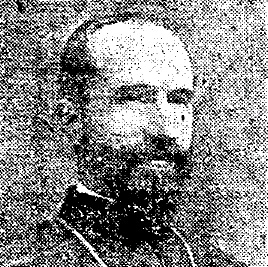Regular readers of this website have no doubt noticed that I am really interested in early American converts to Orthodoxy. There weren’t too many, but the handfuls of people who did join the Church in the late 19th and early 20th century almost always present fascinating stories. The most notable converts, in terms of visibility, tend to be clergymen from other Christian groups, e.g. Fr. Ingram Nathaniel Irvine or Fr. Raphael Morgan. But I would guess — and I don’t have any hard data on this, but I think it’s a reasonable theory — that most of the American converts to Orthodoxy at the turn of the last century were women.
The vast majority of Orthodox Christians in America in 1906 were male. In fact, we’ve got some solid numbers on that — according to the Census of Religious Bodies conducted that year, only 14.8% of American Orthodox parishioners were female. Among the Greeks — by far the largest group — that number was 6.1%. As you might expect, a lot of those Greek men were single, and many of those Hellenic bachelors found American brides. And while those American wives didn’t always join the Orthodox Church, many of them did. I would guess that the majority (and perhaps the overwhelming majority) of early converts were American women marrying ethnic Orthodox men.
St. Sophia Greek Orthodox Church in Washington, DC was founded in 1904. By 1906, its priest was Fr. Joachim Alexopoulos, who later became one of the first bishops in the Greek Archdiocese. In June 1906, one of the DC Greeks, Nicholas Pappajohn (who had Anglicized his name to “Davis”) married a German-American girl named Helen Mohr in an dual Lutheran-Orthodox ceremony.
The whole thing took place in a local hall, rather than a church. An improvised altar was set up, and a local Lutheran pastor married the couple in a standard Lutheran ceremony. At the close of the service, the pastor left, and Fr. Joachim Alexopoulos entered, and celebrated the Orthodox wedding service from beginning to end. He certainly didn’t concelebrate with a Lutheran minister, but this compromise was apparently deemed acceptable to all parties. (Details from the Washington Post, 6/25/1906.)
Another, more complex, scenario played out the same year. In January, Nicholas Pappajohn/Davis’ good friend, a Mr. Anagost, married a German-American woman named Mollie Dietz. Although Ms. Dietz was of German ancestry, she was an Episcopalian, and the couple was married in an Episcopal church. But they didn’t turn around and celebrate an Orthodox ceremony, as did the Davis couple in June. Instead, the new bride spent the next nine months studying the Orthodox faith, preparing to be baptized into the Orthodox Church. The Washington Post (9/17/1906) reports, “Although it is not required, it is considered desirable that all who receive the Greek sacrament of marriage should be baptized according to Greek rites, so Mrs. Anagost, after study and preparation, decided to give up her old church affiliations and cast her lot with her husband’s church.”
Mollie Anagost was thus baptized in September, and she and her husband were then wed in an Orthodox ceremony. Her godfather was the aforementioned Nicholas Davis. The godmother, according to the Post, was Helen Davis, the newlywed Lutheran. It’s not clear whether Mrs. Davis converted to Orthodoxy shortly after her marriage and thus was actually the godmother, or whether she was merely on hand to provide assistance.
The whole Greek congregation was present at the beginning of the baptism. Mr. Anagost translated the priest’s words into English for his wife, and she swore that she was joining the Orthodox Church not out of compulsion, but by free choice and out of a sincere belief in the teachings of the Church. It was up to the godfather, Nicholas Davis, to decide the baptismal name of Mollie Anagost, and he chose “Sophia.”
The Post reports that, when the time came for Mollie to be immersed, “the congregation moved toward the kitchen, leaving Mrs. Anagost with her mother, husband, and priest. The real baptismal service was not performed in public, for only a night robe is worn, and the body is entirely dipped in the consecrated water.”
Once Mrs. Anagost was initiated into the Church, she joined the rest of the congregation, who crowded around her and congratulated her. The Post reporter, Elizabeth Ellicott Poe, writes, “The Post reporter was called back and a silver quarter presented to her in observance of the ancient Grecian custom of giving coins to the witnesses, especially those who left first… With hearty congratulations, these friendly Old World people prepared for an evenign of festal enjoyment.” The following Sunday, Mr. and Mrs. Anagost were married in an Orthodox ceremony.
I am interested in the contrast between the two couples, the Davises and the Anagosts. As I said, the Anagosts were married in the Episcopal Church back in January, but waited to have an Orthodox ceremony until after Mrs. Anagost was baptized in September. The Davises, on the other hand, had back-to-back Lutheran and Orthodox services, one right after the other. I can’t tell whether Mrs. Davis became Orthodox or not, but if she did, it wasn’t until after her wedding(s). Thus, in one parish, we see two very different approaches to “mixed marriage.”
[This article was written by Matthew Namee.]
